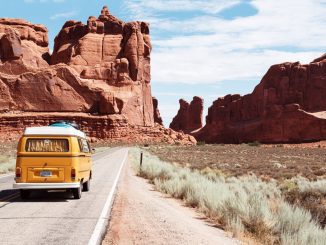If your idea of a road trip is three hours on a well-maintained surface with two stop-offs for snacks before reaching your five-star hotel, your idea of road trips is cute at best. That’s not a road trip. That’s just what family cars are for. So, what’s a real road trip?

Real Road Trips
Real road trips are a modern-day equivalent of setting sail for foreign shores. You know which way you’re headed, but that’s open to change. And that means you need to plan for the unexpected. Taking two weeks off from work and setting out to explore the subtleties and oddities that lie a little more inland than the coastline, for example, is a perfect way to trip the roads in search of stories to tell.
You can also step out of your comfort zone to challenge yourself by taking on the most popular hiking trails and discover the wonders of nature. But before you go on adventures, you need to prepare yourself well.
Just one thing – you’ll need clothing that is strong and resilient, especially if you are planning a trip that will involve laborious volunteering, or outdoor work to keep your funds intact (check out https://fxdworkwear.com.au for workwear inspiration). On top of this, you’re not ready to explore backwater rocky terrains and off-road tourist traps in your flip-flops. Special forces units, maybe. But you and your mate Sam in an ageing Honda? No. You need outdoor boots and long trousers – at least – to protect you from the spikey things and bitey things that live and look menacing at ground level. You have been warned.

Take a Map (printed on paper)
Sat-navs can sometimes hinder explorers. The quickest route between A and B may be a straight line, but that leaves no room for following the signs and taking in some of the weird and wonderful attractions that take your fancy along the way. Nobody ever found anything other than their destination by following a sat nav.
Keep technology to hand, of course, because getting lost is no fun. But for the most part, following your sense of adventure and taking in every small town café along the way can help give you a sense of how others live.
Of course, you can always rely on your smartphone’s GPS, but heavy use while touring will drain the battery easily. So, a printed map will be your best bet. It will also be a good idea to stay off social media and use your phone only when necessary.
Tools and knowledge
Before you leave, watch a YouTube video or two on how to fix a flat. Make sure you have the tools on board. Calling a tow-truck is no way to explore. You might also want to consult the world wide web on common issues with your car (is your car suitable?).
For example, does it have regular overheating issues? Does the air con break down a lot? Are there easy fixes that you can take with you in your back pocket and be ready to apply at a moment’s notice? Getting on board with self-sufficiency during road trips is what it’s all about.
Preparation is key, but there are things you just can’t avoid when you’re in the wilderness. Hence, the best thing to do is to have a backup plan ready. Think of the worst-case scenarios that you might have to deal with and come up with solutions. What if it rains or the weather gets too cold? Knowing what to do will help you save time and avoid any hassle. Moreover, don’t forget to wear the right gear, such as quality Workwear products, so you’ll feel comfortable. A well-planned road trip is an exciting adventure you’ll want to embark on again.
Storage
You see, road trips mean you’re going to need space for water. You’re also going to need room for food. And clothes. And somewhere to tuck away any trinkets you pick up for your loved ones back home.
If you think the back seat and the boot/trunk of the car will suffice as a general all-purpose storage solution, you’d be right but only to an extent.
While road tripping, your car is your home. Think about preparing for the various storage needs you’re going to run into before you leave. You won’t regret it.
Aside from storage, identify the necessities or supplies and have them ready. You can keep a checklist of essentials for the trip, so you can be sure you have everything you need. For instance, you should stock up on emergency essentials, like a first aid kit, a flashlight, a blanket, and car tools.



